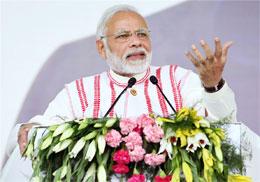India’s public health plan targets 100 million families

India has launched the world’s biggest public health scheme promising free coverage for half a billion of its poorest citizens.
The National Health Protection Scheme, popularly known as “Modicare,” plans to provide around $7,000 of medical coverage to 100 million families or 500 million people, accounting for around 41 percent of people who fall below the poverty line.
“The aim is to provide medical care to the people standing at the very margin of society. It has been a dream to provide health care to the needy and that dream is coming true today,” Indian prime minister Narendra Modi said in a speech after inaugurating the scheme.
“This is the first time in the world that a health care program is being launched where an individual will have an insurance cover of 5 lakh rupees ($7,000),” he said as the schema was launched ahead of the May elections.
The program has been launched in 400 districts out of 640 in India.
The intervention is meant to take the burden off the government hospitals and bring the expensive private hospitals within the reach of poor people.
But critics and political rivals have questioned how the government plans to fund such an enormous safety net.
“This is going to be another scam. It will benefit only private insurance companies. The citizen of the country will realise later that it is nothing but an election gimmick,” said Sanjay Nirupam from India’s main opposition Congress Party.
“There is a lack of clarity on this issue in the new scheme as well,” says Dr. Shakil, a cardiologist based in Patna, the capital of the eastern Indian state of Bihar.
Talking to Arab News, he asks: “How will you identify the real beneficiaries? Besides, the scheme will not build public health infrastructure but give benefit to the private players, which I think is the real drawback of this policy.
“The government is in a hurry to launch the scheme and not many preparations have gone into it before inaugurating it.”
Economist Venkat Narayana questions the budgetary provisions for the scheme. “Under the scheme 60 percent of expenses would be borne by the central government and 40 percent by the state government. But the poorer states cannot afford the huge sums involved in the expenditure,” says Narayana, who also runs NGOs for poor people in Warangal district in the South Indian state of Telangana.
“My experience suggests that such a program does not address the real health care needs of the people living in villages and smaller cities. The money that the government plans to spend on insurance can be spent in expanding and enriching the medical infrastructure across the country.”
Over the past few decades, rapid economic growth has allowed millions of Indians to lift themselves out of poverty. But the lack of quality and affordable medical care has meant that millions continue to be deeply vulnerable to health shocks.
A Mint analysis of data from the last National Sample Survey Office health survey conducted in 2013-14 shows that 36 million households incurred health expenses that exceeded the annual per capita consumption of those households.
Catastrophic health shock is defined as something that leads to annual expenses greater than the annual per-capita consumption of a household.
While the poorest are the most exposed financially to health shocks, even among those who are better-off, a significant proportion face health-related financial shocks.
Many families are simply too poor to contemplate a long-haul hospital stay.
The measures are Modi’s latest attempt to reform a public health system that faces a shortage of hospitals and doctors. The government has also in recent years capped prices of critical drugs and medical devices and increased health funding.
Still, India spends only about 1 percent of its GDP on public health, among the world’s lowest, and the health ministry estimates such funding leads to “catastrophic” expenses that push 7 percent of the population into poverty each year.









